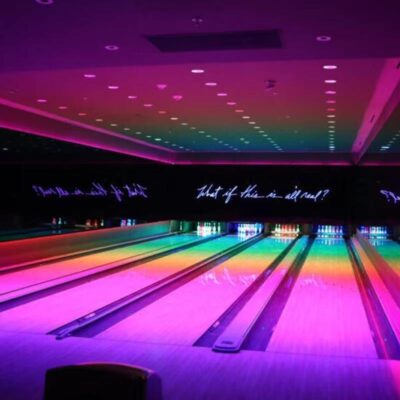1. Why Preventive Maintenance Matters More Than Repairs
Bowling lane machines are the unsung heroes of every bowling center. They handle thousands of oiling cycles each month, yet are often overlooked until they malfunction. A strategic preventive maintenance plan doesn’t just prevent breakdowns—it also extends your equipment’s operational life, protects your lane investment, and ensures consistent gameplay quality.
Working with a professional Bowling Equipment Manufacturer allows you to establish standardized maintenance procedures, access reliable spare parts, and maintain consistent performance across multiple lanes.
2. Understanding the Bowling Lane Machine Lifecycle
Each lane machine has distinct wear points: rollers, belts, oil pumps, and sensors. These components operate in high-dust, oil-rich environments—ideal conditions for gradual failure if left unmaintained.
Typical component life expectancy:
Roller assemblies: 1–2 years (depends on oil pattern load)
Brush and pad heads: 9–12 months
Oil pumps: 18–24 months
Control sensors: 2–3 years
By understanding each component’s cycle, managers can create proactive replacement schedules that reduce surprise downtimes.
3. Daily, Weekly, and Monthly Maintenance Checklist
A consistent routine ensures stability and minimizes service calls.
Daily tasks:
Clean the oil tank and filter screens.
Inspect wipers and check for oil residue buildup.
Calibrate pattern consistency after the first few lanes.
Weekly tasks:
Examine the belt tension and motor alignment.
Check cable connectors for wear or moisture.
Verify sensor accuracy on foul lines and endpoints.
Monthly tasks:
Perform a full diagnostic cycle test.
Replace worn rollers and clean brush assemblies.
Backup all oil pattern settings digitally.
This rhythm not only reduces breakdowns but also creates predictable operating costs—vital for long-term ROI calculations.
4. Choosing the Right Machine for Your Center
Not all bowling lane machines are built equal. Compact venues may prioritize portability and fast oiling cycles, while large centers demand automated self-cleaning and programmable patterns.
When evaluating models, consider:
Speed: Average lanes serviced per hour
Noise level: Especially important for shared entertainment zones
Oil pattern memory: Should support multiple pattern profiles
Remote diagnostics: Useful for multi-location operations
You can consult an experienced Bowling Lane Machines Manufacturer to choose the right model and ensure proper installation, software updates, and training.
5. Oil Management and Environmental Efficiency
Proper oil management is both a performance and sustainability factor. Excessive oil waste not only raises costs but can also impact environmental compliance.
Implement oil recycling protocols, and ensure that cleaning chemicals are non-corrosive and eco-friendly. Many new machines are designed with low-oil-consumption systems and auto-shutoff functions to minimize waste.
6. Training and Human Factors
Even the most advanced equipment requires skilled operators. Consistent staff training ensures that daily checklists are followed and minor issues are reported early.
Create a “maintenance responsibility matrix” assigning clear roles:
Technician: Hardware inspection and calibration
Operator: Daily cleaning and surface checks
Manager: Scheduling and spare-part budgeting
7. Predictive Analytics and IoT Integration
Modern bowling lane machines increasingly include IoT sensors and cloud-based analytics. These allow you to monitor usage cycles, oil consumption, and system health remotely. Predictive alerts help you act before failures occur—saving both time and profit.
For example, if oil consumption spikes 15% above normal, your sensor system may flag potential leaks or clogged filters before visible malfunction.
8. The Cost-Benefit Perspective
Preventive maintenance can cut emergency repair costs by up to 40% annually. While it requires an upfront commitment to scheduling and record-keeping, the long-term savings are substantial.
Centers that maintain clean and reliable lanes also enjoy higher customer satisfaction and return rates—turning maintenance into a silent marketing tool.
9. Common Mistakes to Avoid
Skipping calibration after every 10–15 lanes
Ignoring software updates for oiling patterns
Mixing incompatible lubricants
Waiting until breakdowns to order spare parts
Avoiding these mistakes can easily add 2–3 years of operational life to your machines.
10. Final Thoughts
Preventive maintenance isn’t an optional task—it’s a business strategy. Bowling centers that treat maintenance as part of daily operations achieve longer machine lifespan, better performance, and higher profitability.
Partnering with a professional manufacturer ensures that your preventive maintenance program is supported by reliable equipment, expert guidance, and readily available parts.
FAQs
Q1: How often should bowling lane machines be serviced by a technician?
At least once every quarter, in addition to regular in-house maintenance routines.
Q2: Is preventive maintenance cost-effective for small bowling centers?
Yes. Even small centers benefit from reduced downtime and longer equipment lifespan, making it one of the best cost-saving strategies.
Q3: What’s the first sign a lane machine needs attention?
Inconsistent oil patterns, increased noise, or delayed cleaning cycles are early signs that maintenance is overdue.







